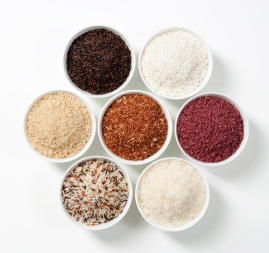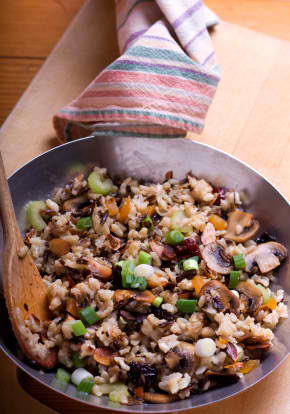Brown Rice – Non-Organic May Not Be A Good Choice
Posted on 22. Jul, 2010 by admin in Blog
 Rice is the most consumed staple food in any household settings. There are different variety of rice but we are only focusing on white rice and brown rice. In history, brown rice is linked with poverty and wartime. This is considered a peasant food or animal food to most people living in ancient years.
Rice is the most consumed staple food in any household settings. There are different variety of rice but we are only focusing on white rice and brown rice. In history, brown rice is linked with poverty and wartime. This is considered a peasant food or animal food to most people living in ancient years.
Rice is an acidic food but it doesn’t mean that you should remove it from your diet. Remember, we are not trying to achieve 100% alkaline but 70-80% alkaline. Furthermore, rice provides our body with carbohydrates which converts into energy in our body.
Brown rice is the whole and natural grain with mild nutty flavor. Actually, white rice is brown rice in nature: the only biological difference of brown rice is the intact bran which is not removed. It was in 1986 when complex processing equipment was developed to turn brown rice into white grain. Since then, white rice has gone through lots of process and losing its nutritional value.
Clinical Studies on Brown Rice versus White Rice
In modern days, brown rice grabbed the attention of health professional due to its health benefits. Researchers from Harvard School warned the consumers about the health risk of consuming five or more servings of white rice. This is based on the result that was originated on the comparative study of white rice versus brown rice.
There is a connection between the cases of Type 2 diabetes and the reported increase rate of white rice consumption in the United States. On the contrary, a study revealed how brown rice can reduce the risk of type 2 diabetes by increasing the consumption of at least two or more servings weekly.
In the study conducted, there are 39,765 men and around 57,463 women who participated on the research. It was a long period of clinical involvement that was started in 1984. The respondents were asked to update their diet sheet information every 4 years. Surprisingly, during those years, almost 10,000 participants were unfortunately developed Type 2 diabetes.
These are the group of respondents who love to consume white rice on their daily diet. Same results were published in a 2007 study in Shanghai to middle –aged women who are consuming large amounts of white rice and other types of refined carbohydrates.
Brown Rice versus White Rice
What makes brown rice different from white rice? The answer is simple: it is the end result of the botanical structure of grain during the refining stage. The whole brown rice does not undergo several process like white grains, therefore it maintain its original form, with the bran still intact and loaded with natural concentrations of vitamins and minerals. The process of refining white rice tends to lose essential vitamins and minerals including fiber, magnesium, lignans, phytoestrogens, and phytic acid.
In 1987, it was found that white rice can cause beriberi, a deadly disease caused by vitamin B1 deficiency. Strict government policy was implemented since then in some countries. The manufacturers are obliged to put back the vitamins and minerals by adding powdered nutrients to white rice. What is most striking about brown rice is the high quantity of fiber.
Nevertheless, the amount of phytochemical, most especially the fiber, is still lacking and not compensated by adding the enrichment. Moreover, brown rice offers all the vitamin B complex like thiamin, riboflavin, and niacin which our body needed in order to release energy for our survival.
This energy processes breathing, brain function, blood circulation and supporting the body through demanding physical activities. Without getting essential vitamin B, our body systems and functions will slow down.
Another thing, other clinical studies showed that white rice contains higher glycemic index. This measure how fast a particular food raises blood glucose levels that may lead to more drastic insulin reaction after two to three hours after eating.
Those foods considered high in glycemic index are rich in carbohydrates including white rice. That is the reason why white rice has been linked to Type 2 diabetes, but the brown rice has lower glycemic index that will not affect the glucose level.
Now, at this point you may want to switch to brown rice but here’s the thing, should you get non-organic or organic brown rice? After all, non-organic are much cheaper.
Non-Organic versus Organic Brown Rice
Due to the cultivation process in farm wherein arsenic-based pesticides are widely used, soil and water get contaminated and have harmful effects on the crops, particularly the unpolished brown rice. This is revealed in several studies that non organic brown rice has small traces of arsenic and can pose negative effects on the body in the long term. In one of the studies conducted in Aberdeen University and carried out for the Food Standards Agency, arsenic has been found to be one of the carcinogens that may cause cancer. Also, the risk of lung, bladder, and kidney cancer increases with large amount of arsenic intake.
The loads of benefits can never outweigh the risks of toxic arsenic in our body. Therefore, organic brown rice is the best healthy option. Organic brown rice is worth it not just because it is eco-friendly, but most and foremost; it can guarantee the complete wellness of our family.
Why white rice dominated the market?
 If brown rice offers more nutritional value, you may be thinking why most people preferred white rice over brown rice. For those who are not aware, the long shelf life of white rice is the main factor why it is boom in the market. White rice industries are making more money in selling the grain due to its much cheaper price compared to brown rice. Even though the equipment is expensive to produce white rice, more companies are well-equipped to produce it.
If brown rice offers more nutritional value, you may be thinking why most people preferred white rice over brown rice. For those who are not aware, the long shelf life of white rice is the main factor why it is boom in the market. White rice industries are making more money in selling the grain due to its much cheaper price compared to brown rice. Even though the equipment is expensive to produce white rice, more companies are well-equipped to produce it.
Most importantly, on the part of the consumers, white rice is easy to cook. So, even though our modern times considered brown rice to be healthier than to any of its grain counterpart, for the vast majority, a meal without white rice is not complete.
Given all the advantages of brown rice, in the end, it is always the consumers who will dictate the demand in the market. Yet, sad to say that it also indicates how limited our knowledge regarding which is better for our health. More often than not, people stay with what they have been accustomed to and white rice has been part of their daily diet. That is well given and well taken. However, only if people would be smart consumer, we can totally get rid of the white rice and shift to a much healthier choice: organic brown rice with its loaded nutritional benefits.





Recent Comments